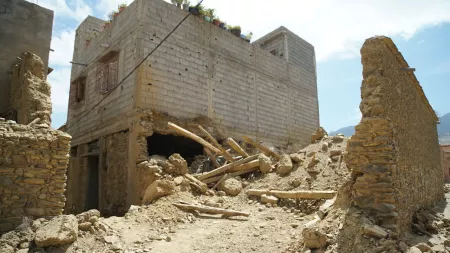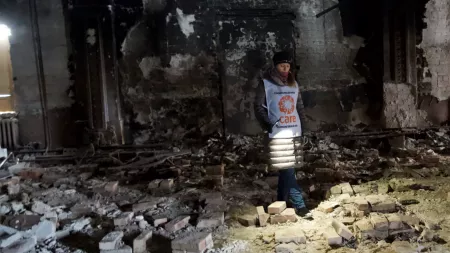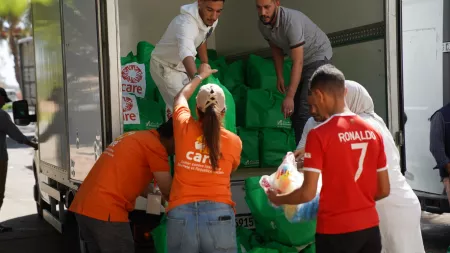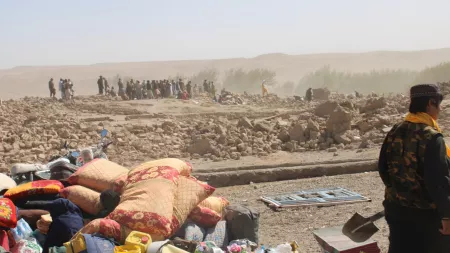The onset of winter this year comes at a particularly dire moment for those whose lives have been upended by humanitarian crises, many of which are unfolding concurrently. While millions are reeling from war, climate emergencies, earthquakes and other disasters, global funding to meet unprecedented needs around the world remains grossly inadequate. In these most fragile contexts, people who were already struggling to survive, many living in tents or other makeshift shelters, must now deal with below zero temperatures, freezing rain and heavy snow, all while lacking basic necessities and resources.
The most vulnerable – children, women, the elderly – are at higher risk during the winter months.Deepmala Mahla, VP of Humanitarian Affairs at CARE.
“For those coping with such horrific loss and trauma, winter will make their situations exponentially worse. Many tents and other temporary shelters are old and dilapidated, offering little refuge from the harsh conditions. And countless families do not have the means – no suitable clothes, no blankets, no heating – to keep themselves warm. The most vulnerable – children, women, the elderly – are at higher risk during the winter months,” said Deepmala Mahla, CARE’s VP of Humanitarian Affairs.
This year, the world watched as hundreds of thousands in Türkiye, Syria, Afghanistan, Nepal, and Morocco were uprooted from their homes due to several catastrophic earthquakes. In other parts of the Middle East as well as in Ukraine and the South Caucasus, it is armed conflict that has pushed populations to the brink. CARE and other organizations continue to provide lifesaving aid in these regions, but with global humanitarian response plans only 35% funded, more international support is desperately needed, particularly this winter as frigid temperatures and snow will add a new layer of suffering onto the lives of survivors.

“For Turkish and Syrian communities already living in very precarious circumstances in the earthquake affected areas in southeastern Türkiye, the winter is another big challenge. More than 100,000 households are in formal container sites, while more than 50,000 households are in foldable and inadequate containers and tents,” said CARE Türkiye Assistant Country Director, Zena Ni Dhuinn Bhig.
“Average minimum temperatures in these areas reach 0°C or lower, with snow expected in rural areas in Adiyaman, Kahramanmaraş, and Malatya, early on in winter making these areas a priority for winterization interventions. CARE operates in 11 of the hardest hit areas between Hatay and Gaziantep, providing shelter and cash assistance for winterization items; however, the needs are great and will continue to grow as long as the earthquake response remains underfunded,” added Bhig.
As we face major funding gaps, our ability to respond to the winter needs of vulnerable communities is dwindling by the yearJolien Veldwijk, CARE Syria’s Country Director.
“Many people in northeast Syria, like in most parts of Syria that have been impacted by the conflict and economic crises, cannot afford the basic necessities for keeping warm in the winter,” said Jolien Veldwijk, CARE Syria’s Country Director. “The winter in northeast Syria is exceptionally cold, with temperatures reaching 0°C. As we face major funding gaps, our ability to respond to the winter needs of vulnerable communities is dwindling by the year, meaning that we are forced to prioritize providing the very basic necessities such as winter clothes and plastic tarpaulin sheets to help insulate the fraying tents. There is still a great need though for replacing people’s tattered tents and providing other necessities like mattresses and blankets, especially given that the majority of people can’t afford fuel to keep warm inside the tents.”
In war-torn Ukraine, millions already impacted by more than a year and a half of armed conflict are bracing for another harsh winter. In fact, since the beginning of November this year, over 100 towns in Ukraine experience daily shelling. “In partnership with national non-governmental organizations (NGOs) and governmental agencies, CARE Ukraine actively engages in facilitating access to hard-to-reach areas,” said Fabrice Martin, Country Director at CARE Ukraine. “Our primary focus lies on delivering essential resources to the local population, including vital items such as thermal underwear, gas heaters, warm blankets, pillows, and solid fuel. Concurrently, our commitment extends to ensuring that emergency services operating in these regions are equipped with the necessary tools and supplies to effectively carry out their responsibilities.”

Beyond Eastern Europe and the Middle East, CARE is carrying out “winterization” efforts in other regions as well.
In Morocco, where an earthquake on September 8 killed nearly 3,000 people and destroyed 50,000 buildings – mostly people’s homes – many survivors are living in temporary shelters, as temperatures already are below freezing in some places. In affected areas, CARE is looking to provide winterization kits (blankets, mattresses, sleeping bags, hats, socks, etc.), shelter repair items, and hygiene kits (soap, shampoo, menstrual pads, baby wipes, toilet paper, etc.) for 1,450 households – about 7,250 people.

In Armenia, a massive influx of approximately 104,000 people fleeing military action in Nagorno-Karabakh is overwhelming the resources of the small landlocked country. CARE, through local partners, has already distributed warm clothes and blankets for 500 people in emergency shelters and other temporary locations. Through the end of the year, CARE is also preparing to distribute emergency food packages for 500 people – prioritizing women, children, and the elderly – along with additional blankets and warm clothes for 2,000 people. CARE is also planning to provide vital equipment and supplies to emergency shelters to create a safer environment, particularly for women and girls.
Afghanistan is experiencing multiple crises including the recent earthquakes in Herat that caused widespread destruction, killing at least 1,480 people and injuring 2,100 others. With more than 10,000 homes destroyed in the province, an estimated 114,000 people are in dire need of humanitarian assistance. To support residents, CARE is providing winterization assistance to 4,345 households – around 30,415 people – including families led by women, children, people with disabilities, and other individuals in need. This assistance includes winter clothes kits, blankets, and cash.
For media inquiries, please contact Iolanda Jaquemet, Senior Humanitarian Communications Coordinator, CARE International via: [email protected].
